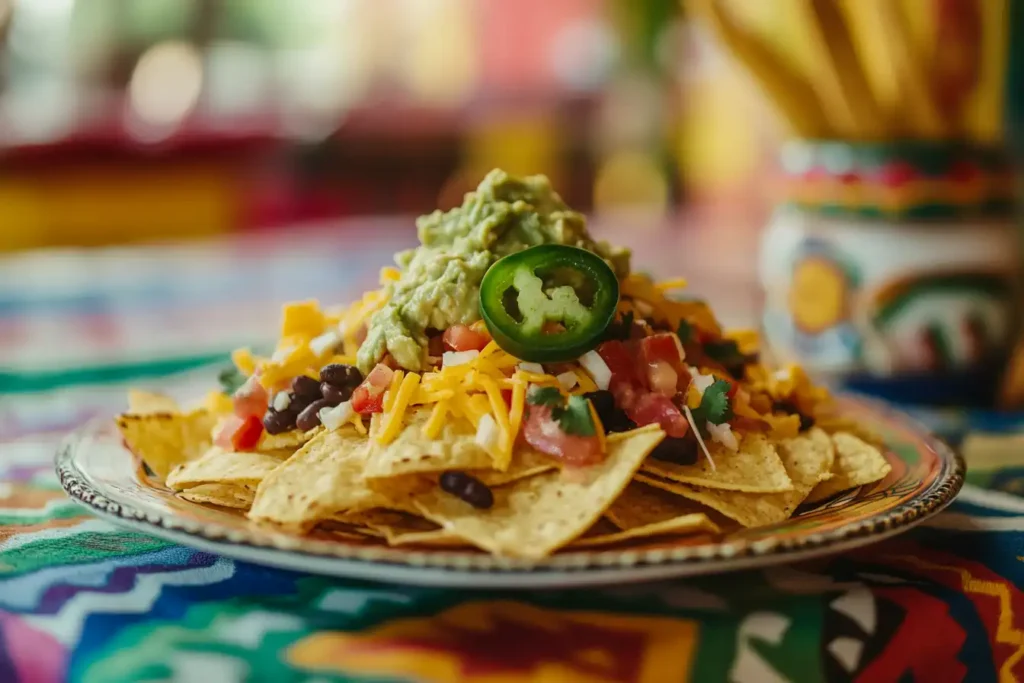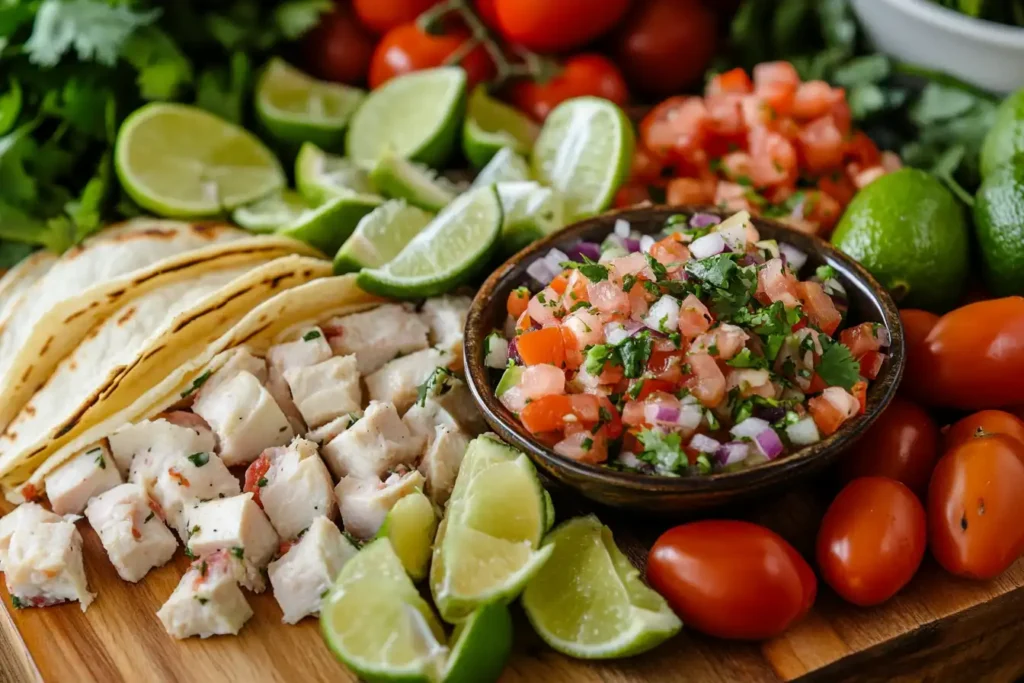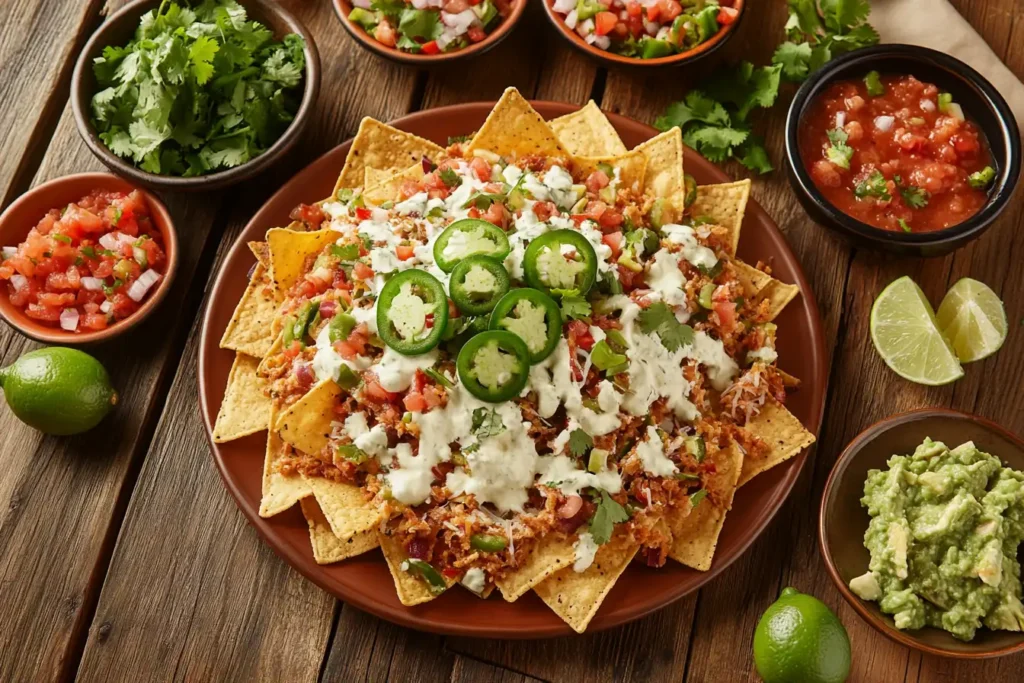Mexican cuisine is a kaleidoscope of flavors, textures, and traditions, offering something for every palate. Among its vast array of dishes, nachos and botanas stand out as popular favorites. But here’s the catch—while many people use the terms interchangeably, they’re far from the same! This article dives deep into the intriguing world of nachos and botanas, exploring their origins, key differences, cultural significance, and much more. By the end, you’ll not only know what’s the difference between nacho and botana, but you’ll also have a newfound appreciation for both.
Exploring Nacho and Botana: What’s the Difference?
What Are Nachos?
Nachos are more than just a snack; they’re a global sensation. This beloved dish, typically made with crispy tortilla chips, melted cheese, and toppings like jalapeños or salsa, has carved its niche in the culinary world. Nachos originated in Mexico and quickly gained massive popularity abroad, often appearing as appetizers, party snacks, or even full meals.
At their core, nachos are defined by their simplicity and versatility. Whether loaded with guacamole, beans, or shredded meat, they’re a crowd-pleaser for casual dining and social gatherings alike.
What Makes a Botana Different From Nacho?
The term botana translates to “snack” in Spanish, but it encompasses so much more. In Mexican culture, botanas are a variety of small, shareable dishes often served during social gatherings. Think of it as a tapas-style offering—platters featuring everything from quesadillas and tostadas to nuts and spiced fruits.
Unlike nachos, which are specific in composition, botanas are a category of foods rather than a single dish. Mexican culinary tradition roots them in the joy of sharing and celebrating with friends and family.
Why the Confusion Between Nacho and Botana?
It’s easy to see why people confuse the two. Nachos, often served as part of a botana platter, blur the lines between these categories. In casual settings, a plate of nachos might be one of several offerings labeled as botanas. However, the distinction lies in the details: nachos are a defined dish, while botanas are a broader concept encompassing many options.
Origins and History of Nacho and Botana: Understanding Their Differences
The Invention of Nachos From Ignacio to the Global Plate
Nachos owe their origin to Ignacio “Nacho” Anaya, a Mexican maître d’hôtel who, in 1943, improvised a dish for hungry patrons. Using what he had on hand—tortilla chips, melted cheese, and jalapeños—he unknowingly created a culinary icon. Today, nachos are celebrated worldwide, but their humble roots in Piedras Negras, Mexico, remain a source of pride.
The spread of nachos into American culture during the mid-20th century cemented their status as a game-day snack and a casual dining favorite. Their journey highlights how simplicity, paired with bold flavors, can resonate universally.
Botana in Mexican Culinary Tradition: A Cultural Perspective
Unlike nachos, botanas have a broader cultural significance. Stemming from the Spanish word for “snacks,” botanas are an integral part of Mexican social gatherings. They are not a specific dish but a medley of shareable foods like peanuts, quesadillas, tostadas, or ceviche. The concept of botanas ties closely to family traditions and celebrations, reflecting the communal essence of Mexican cuisine.
Botanas are most often served in cantinas, particularly on festive occasions or alongside a refreshing drink. Moreover, this cultural context highlights the emphasis on togetherness and the sheer enjoyment found in Mexican dining.
How History Helps Us Understand What’s the Difference Between Nacho and Botana?
Both nachos and botanas evolved differently due to their origins. Nachos were popularized through commercialization, becoming a staple in cinemas, sports events, and fast-food chains. Meanwhile, botanas retained their traditional essence, remaining a symbol of Mexican hospitality and culinary diversity.
While nachos embraced fusion and innovation—think loaded nachos with pulled pork or vegan cheese—botanas stayed rooted in authenticity, representing regional flavors and ingredients. This divergence underscores the rich tapestry of Mexican culinary traditions.
Key Differences Between Nacho and Botana: What Sets Them Apart?

Ingredients: What Sets Nacho and Botana Apart?
One primary distinction lies in ingredients. Nachos revolve around a simple trio: tortilla chips, cheese, and toppings like beans or jalapeños. Conversely, botanas encompass an extensive range of finger foods, from crunchy chicharrón to guacamole-dipped veggies.
Botanas are more adaptable, featuring a wide variety of ingredients, depending on the occasion and region. Nachos, however, have a set formula, with variations arising from added toppings.
Presentation and Serving Styles
Nachos are typically served on a single platter, designed to be easily shareable but also neatly layered. Botanas, in contrast, are presented as a collection of different small dishes, encouraging a more interactive dining experience. This variety lets diners pick and choose, making botanas ideal for large gatherings.
Cultural Contexts: Snack or Shareable Dish?
Culturally, nachos have become synonymous with fast, indulgent comfort food. They’re perfect for casual hangouts or watching sports. On the other hand, botanas embody conviviality. They are about savoring the moment, often paired with drinks like tequila or beer in Mexican social settings.
Where They Are Found: Popularity in Mexico vs. Abroad
While nachos enjoy global recognition, botanas are more commonly experienced in Mexico. In Mexican cantinas or homes, botanas are a must-have, but they are less prominent outside the country. Nachos, by contrast, are ubiquitous, easily found in restaurants, cinemas, and stadiums worldwide.
Nutritional Information
Understanding the nutritional content of your favorite snacks can help you make informed choices. While both nachos and botanas can be tailored for health-conscious eaters, their nutritional profiles vary based on ingredients and preparation methods. Below is a breakdown of the average nutritional values per 100 grams of traditional nachos and a typical botana platter.
Nutritional Content Table (Per 100g)
| Nutrient | Nachos (Traditional with Cheese and Jalapeños) | Botanas (Mixed Snacks like Quesadillas, Guacamole, and Fruits) |
|---|---|---|
| Calories | 300 kcal | 220 kcal |
| Protein | 7 g | 4 g |
| Fat | 18 g | 12 g |
| Saturated Fat | 5 g | 3 g |
| Carbohydrates | 28 g | 20 g |
| Fiber | 2 g | 3 g |
| Sugars | 2 g | 6 g |
| Sodium | 450 mg | 300 mg |
| Vitamin C | 2% DV | 8% DV |
| Calcium | 15% DV | 10% DV |
| Iron | 5% DV | 6% DV |
Key Takeaways
- Nachos tend to be higher in calories and fat due to the cheese and chips but provide more protein.
- Botanas are often lower in calories and fats, especially when they include fruits and fresh vegetables, but may have more natural sugars from these ingredients.
- Choosing healthier toppings, like low-fat cheese or fresh salsa, can make nachos more balanced. For botanas, incorporating more plant-based items like guacamole or ceviche can boost fiber and nutrients.
Both nachos and botanas can fit into a balanced diet when enjoyed in moderation. By customizing ingredients, you can make these dishes suit your dietary needs without sacrificing flavor!
How Nacho and Botana Are Prepared: A Closer Look at the Differences

Classic Nacho Recipe: Ingredients and Steps
Nachos are straightforward to prepare but incredibly satisfying. The base is always crispy tortilla chips. From there, a layer of melted cheese forms the heart of the dish. Additionally, toppings like jalapeños, black beans, or guacamole often enhance its flavor. Here’s a simple method to make them at home:
- Spread tortilla chips evenly on a baking tray.
- Sprinkle shredded cheese, such as cheddar or Monterey Jack, generously over the chips.
- Add optional toppings like cooked ground beef, black beans, or diced tomatoes.
- Bake in a preheated oven at 350°F (175°C) until the cheese melts.
- Serve hot with sides like sour cream or salsa for dipping.
Nachos thrive on customization; in fact, you can easily experiment with different cheeses or add-ins like pulled pork or vegetarian-friendly ingredients. Furthermore, this versatility allows nachos to cater to various tastes and dietary preferences, making them a favorite for diverse gatherings.
Traditional Botana Variations: Tacos, Quesadillas, and Beyond
Botanas, being a broad category, naturally offer immense variety. For example, a traditional botana spread might include small portions of tacos, quesadillas, ceviche, and even spiced nuts or fruit. Furthermore, preparing botanas involves balancing flavors to create a diverse yet harmonious platter. To illustrate, a sample botana platter might look like this:
- Mini tacos: Made with corn tortillas, filled with meat, beans, or veggies.
- Quesadillas: Small wedges of tortillas stuffed with cheese and grilled to golden perfection.
- Ceviche: A zesty, citrus-marinated seafood dish that adds freshness to the mix.
- Snacks: Think chicharrón, roasted peanuts, or even slices of mango with chili powder.
The beauty of botanas is their adaptability—they can be elaborate for festive occasions or simple for casual snacking.
Regional Adaptations and Fusion Cuisine
As nachos gained international fame, they adapted to local tastes. For instance, Tex-Mex nachos often come loaded with sour cream, guacamole, and seasoned meat, while gourmet restaurants might add truffle oil or artisan cheeses.
Botanas, on the other hand, remain deeply tied to Mexican culture, though modern chefs have infused global influences. You might find sushi rolls styled as botanas or even fusion dishes combining Mexican and Asian flavors.
For inspiration on creating vibrant Mexican spreads, you can explore La Botana Mexican Snacks Recipes, a guide to assembling delicious and colorful platters.
Choosing Between Nachos and Botanas: What’s the Difference?
Events and Occasions: Party Snack vs. Social Shareable
When deciding between nachos and botanas, the occasion plays a key role. Nachos work perfectly for casual, fun-filled settings such as game nights or movie marathons. Moreover, their cheesy, indulgent nature makes them an ideal choice for occasions where simplicity, comfort, and crowd-pleasing flavors take center stage. Additionally, they are easy to prepare and versatile, making them a go-to snack for any laid-back gathering.
Botanas, however, shine in more social or celebratory contexts. Botanas are perfect for mingling, as they encourage guests to sample a variety of flavors. For instance, they shine at family gatherings, Mexican fiestas, or cocktail parties—events where the focus centers on connection, variety, and sharing delicious food.
Pairing Suggestions: Drinks and Side Dishes
Pairing your food with the right drink undoubtedly elevates the dining experience. For instance, nachos pair beautifully with chilled beer or margaritas, which perfectly complement their savory, cheesy profile. Additionally, you can enhance the meal by adding sides like pico de gallo or queso dip for extra flair.
Botanas, with their diversity, pair well with a broader range of drinks. Try serving them with tequila, mezcal, or even a refreshing agua fresca. For example, spicy ceviche botanas balance beautifully with a crisp white wine, while quesadillas pair nicely with a smoky mezcal.
What’s the difference between nacho and botana when it comes to dining? Simply put, nachos are a single dish made to indulge, while botanas are an entire experience, designed to bring people together.
For more ideas on creating vibrant party platters, check out What Is a Botana?, which dives deeper into this delicious Mexican tradition.
FAQs Section
What Is the Difference Between Nachos and a Botana?
The main difference lies in their scope. Nachos are a specific dish made with tortilla chips, melted cheese, and various toppings, while botanas are a category of snacks that include a variety of small, shareable dishes. Botanas can feature items like mini tacos, quesadillas, ceviche, or even spiced fruits, making them a broader concept than nachos. Simply put, nachos are a dish, and botanas are an experience.
What Is a Botana?
In Mexican cuisine, a botana refers to snacks or appetizers typically served during social gatherings. They’re not limited to a single recipe but rather encompass a collection of shareable foods, often prepared with fresh, local ingredients. Botanas celebrate the communal spirit of Mexican dining, emphasizing variety and the joy of sharing.
What Are Nachos Called in Mexico?
Interestingly, nachos are still called nachos in Mexico! However, they’re not as commonly consumed there as they are in the United States. In Mexico, nachos are often simpler, featuring just cheese and jalapeños, as opposed to the heavily loaded versions popular elsewhere.
What Is Considered a Nacho?
A nacho is defined by its key components: a base of tortilla chips topped with melted cheese. Additional toppings like jalapeños, guacamole, or beans are optional but widely loved. The simplicity of the dish allows it to be customized in countless ways, making it a favorite for casual dining.
Conclusion
In the world of Mexican cuisine, both nachos and botanas hold special places. While nachos have gained global fame as a cheesy, indulgent treat, botanas remain a cultural staple, representing variety and the communal spirit of dining. Understanding what’s the difference between nacho and botana helps us appreciate their unique roles in Mexican food traditions.
Nachos, with their defined ingredients and straightforward preparation, cater to individual cravings and casual gatherings. On the other hand, botanas are a celebration of diversity and connection, offering an assortment of flavors that invite sharing and conversation.
Whether you’re in the mood for a comforting plate of nachos or an eclectic spread of botanas, the choice depends on the occasion and your culinary preferences. Both offer a delicious glimpse into the richness of Mexican cuisine, where every dish tells a story of tradition and creativity.
Curious to discover more mouthwatering recipes? Check out What is Reina Pepiada made of? for inspiration and a taste of Venezuelan cuisine.


1 thought on “What’s the Difference Between Nacho and Botana? A Detailed Guide”